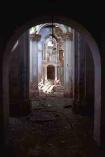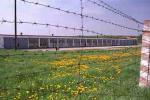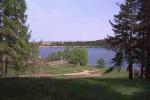Kalvarija's fast development was mainly due to
the fact
that it was along side of the road to St. Petersburg and Warsaw.
By 1827 there were 501 buildings, in 1867 it became central city
of the district which included a courthouse, post office, telegraph
agent, a hospital of 25 beds and 3 doctors.There was also army doctors
in the 2 army units in the barracks there. Kalvarija had a large
jail, several factories for the production of medicinal alcohol,
and a large market.
Russian control continued to 1915. During WW2 the
Germans overthrew the city and surrounding areas. Half of the city was
burnt around
900 buildings. In 1919, with the evacuation of the Germans, Kalvarija
became part of the District of Marionpole in independent Lithuania.
In 1921 Kalvarija was connected to the Lithuanian railroad. In 1926
a hospital, 500 beds, for the mentally ill was moved into what where
once the army barracks. It was one of largest of Lithuanian medical
institutions. During WW2 many buildings were destroyed.
Jewish
Settlement up WWI
There is a good possibility that there was a Jewish presence in
the village of Trabi that was in the weaving trade. As early as
1713 the Jews received permission from King August II to build a
synagogue under the condition that it would not be higher than the
church. Jewish craftsmen also received permission to work without
becoming members of the guilds.
Jews were mainly engaged in trade, crafts, and
agriculture and
in a small part industry. Jews owned more then 80% of the stores
(60 of 72). Grain trade was also in the hands of Jewish merchants
exporting mainly to Germany. There was also a pig's bristles
processing factory for brushes where many Jews were employed. The
workers of this factory organized, under the influence of the "Bund"
during the years 1893-1897. They organized strikes in order to improve
their working conditions to just 10 hours a day, and to improve
their salary which was at a starvation level.
The achievements of the German Jewish community in the
areas of Science and culture made a big impression on the Jewish
community
of Kalvarija and several of the sons of the rich began to study,
along with their religious studies, Russian and German. They
"Germanized"
their Yiddish, which was known as "Kalvaricha Deuth", which was
well known in Lithuania. The German example (culture) on one hand,
and the poverty on the other hand where led to the emigration of
many. Hundreds of the young and young families left the city in
the 80's of the 19th century, mainly to the U S, South Africa and
Eretz Israel. In Kalvarija there were several "specialists " who
made their living by smuggling emigrants through Germany, as this
was cheaper and less complicated.
Most of the Jewish children studied in the
"Heder", in a
few of these Hebrew and grammar were taught as well. There was also
an institution for 150 poor children for the study of Talmud-Torah.
1858-59 with the permission of the local authorities a general school
was created where 80 - 100 young boys and girls studied. Many continued
their studies in the Russian Gymnasium in Suwalk or Marionpole.
In 1871 15 Kalvarija youth studied in these institutions. In 1899
a school for the poor was formed by some of the richer families
to enable them to continue studies after the "Heder".
In 1803 a new synagogue was built with heavy walls of
large stones. The Bima and Tora case was decorated
by an artisan and the walls were also decorated by paintings of
animals. In the courtyard a  Beit
Midrash was
built.
Beit
Midrash was
built.
Social work in Kalvarija. Active charity organizations
(Gimilot Hasidim) gave loans with small weekly return payments. A sick
charity
( Bikor Cholim) gave health services and medicines and a group of
women and young girls gave aid to the sick.
By the end of the 19th century many were learned in
Hebrew and subscribed to the Hebrew press Hamalitz,Hamagid and
Hasharchar.
There is early evidence to aliaya to Eretz Israel as
there are
9 tombstones of former Kalvarijian residents on Mt Olive cemetery
in Jerusalem.In the early 80's youth joined the "Yesod Hamala"
organization with the purpose of Aliya to Eretz Israel. In 1890 the
Zionist movement Hovavei Zion gathered signatures to send protest to
Baron Hirsh
in order to convince him to help resettling Eretz Israel instead
of Argentina. In 1894 the organization " Shcarei Toushia " was formed
in order to educate toward Aliya. In a donor list for Eretz Israel
, in 1909, 120 names from Kalvarija residents.
Autumn 1914 with the beginning of W.W.I Jews were
ordered to hard labor on roads as punishment for their German support.
In the battles
in the area in and around Kalvarija there were 220 casualties to
the Jewish community. Half the city was burnt including the old
wooden synagogue. Most of the Jewish residents were forced to leave
their homes and scattered to other towns in Russia.
At the end of the German occupation many returned and
were in
the need of aid.
Kalvarija during Lithuanian
Independence
With the formation of Independent Lithuania on the 16th February
1918 and the evacuation of the German army at the beginning of 1919,
many of the former resident began to return. With the announcement
of Jewish Autonomy an 11 man committee was formed. This committee
was active in most of the Jewish life during the years 1921-25.
Since most knew Hebrew as well as Yiddish the protocols were written
in both languages page opposite page.
In the local council there was also representation
from the Jewish community. In the election of 1924 a Jew was elected as
Vice Mayor.
In 1934 there were three Jews in the council of nine.
The Jewish community began to rebuild their houses
that were destroyed and many returned to their former occupations. The
economic situation was bad and the store owners suffered most. Grain
trade
also suffered because of the new laws limiting trade. The situation
was so bad that in 1923 a committee sent a letter to the main national
Jewish committee with requests for aid for 97 men women and children
(listed by name) that need clothing.
From a survey conducted by the Lithuanian government
in 1931 there were 72 stores in Kalvarija 60 of which were owned by
Jews. On that
same survey there were 16 factories and small crafts shops in the
hands of Jews. In 1937 there were only 32 in the hands of Jews.
The psychiatric hospital, the largest in Lithuania, offered livelihood
to Jewish contractors and suppliers.
The scenery and pure air that surrounded the city, the
river Sheshupe and the forests beside it drew many Jewish vacationers,
which also
added to the resident's livelihood.
The Lithuanian Organization of Merchants was
against buying from Jews and as a result there was a boycott against
Jewish stores
and craftsmen. The Lithuanian co-operative took in their hands the
agriculture industry exports and the imports of agricultural tools,
seeds, fertilizers etc. and in this many lost their
livelihood.
In 1939 the National Lithuanian Party in Kalvarija proclaimed that
the market day be on the "Shabbat" (Saturday). These were the main
causes of emigration.
In the Jewish school Yavne there were 135 students, in
the Yiddish school 130 students. There was a high school of eight
classes. This institution was in operation till 1935 and was closed
because of
lack of students. A Hebrew kindergarten was active, a library of
2000 books in Hebrew and Yiddish.
From time to time theatre groups would come to
Kalvarija to perform and the local residents also had amateur
performances with the income for Keren Ha Kayemeth, Keren Ha Yesod,
Wizo and Keren Tel Chai.
Zionist groups were active in Kalvarija. There was a
Kibbutz run
by "Ha Halutz" for preparing youth for their aliya. The youth received
Zionist education in the Hebrew schools and the youth movements
and many did reach Eretz Israel. Sport activity was centered mainly
in the local branch of "Maccabi".
There were also volunteers in the local fire brigade. One member
received an award in 1937.
Kalvarija during WWII and after
In 1939 the Germans deported 2,400 Jews from the Suwalk province of
Poland to the border of Lithuania and 800 of these were absorbed and
taken care of by the residents of Kalvarija.
When Lithuania became part of the Soviet republic in
June 1940 factories in the hands of Jews were taken over and put in the
hands
of Komisars. Supplies were limited and prices rose. The middle class
which was mostly Jewish was the hardest hit. Jewish youth movements
were abolished and the Communist youth movement made great efforts
in enlisting youth. Hebrew educational institutes were
closed.
On 22 June 1941, the first day of the war between
Germany and
Soviet Russia, the Germans entered Kalvarija. On the 1st of July
the Lithuanian police proclaimed that all Jews were obligated to
wear the Yellow Star patch, and that they were forbidden to walk
on the sidewalks. Jews were taken to work at hard labor and on the
way to work and back they were humiliated while the Lithuanian
population
watched. At the beginning of July 90 people, Lithuanian communists,
Jewish intellectuals, and others were brought in to the
hotel"Zdarouvitz".
There they were beaten, tortured for several days.On the 5th of
July they were brought to the banks of lake Orios, about 2 km from
the city, where they were shot and buried.

On Shabbat 30th of August all the remaining Jews where
evacuated
to the barracks in Marionpole, under the pretense of being sent
to the ghetto there. All their belongings where left at the Synagogue
and in their empty carts the Jews were transported. All in all there
were 8600 Jews in the Barracks.

On 1st of Sept. 1941 they were all brought to the
banks of river Sheshupe and there near pre dug pits they were shot and
buried.
The Lithuanian police and shot later caught some that managed to
escape. After they had rid themselves of the Jews the locals, at
the head the Priest proceeded in destroying all the Jewish shops
that were in the vicinity of the church and with their bricks built
a wall around it.
During WW2 1/2 the city was destroyed. Nothing was
left of the
old Jewish cemetery. Beit Ha Midrash remained whole is used as a
granary.
After the war only one Jewish family returned and
lived in their
home for about 1/2 yr. In the years 1989-70 there was but one Jew
living in Kalvarija.
In the 1990's the old cemetery was partially
restored.
Bibliography:
Encyclopedia
Judaica
Pinkas
Hakehilot: Lita (Hebrew)
Encyclopedia of
Jewish Communities
Edited by Dov
Levin
502 towns listed
Yahadut Lita (
Hebrew)
return
to menu